试谈世界电力机车的发展(doc 8页)
- 格式:doc
- 大小:3.15 MB
- 文档页数:9
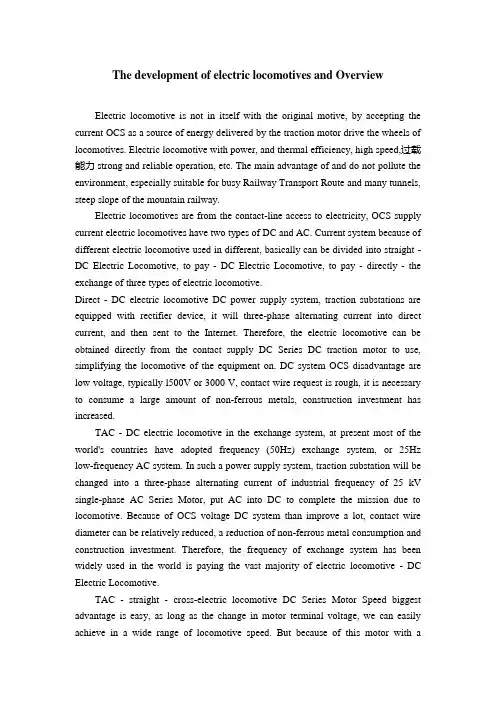
The development of electric locomotives and OverviewElectric locomotive is not in itself with the original motive, by accepting the current OCS as a source of energy delivered by the traction motor drive the wheels of locomotives. Electric locomotive with power, and thermal efficiency, high speed,过载能力strong and reliable operation, etc. The main advantage of and do not pollute the environment, especially suitable for busy Railway Transport Route and many tunnels, steep slope of the mountain railway.Electric locomotives are from the contact-line access to electricity, OCS supply current electric locomotives have two types of DC and AC. Current system because of different electric locomotive used in different, basically can be divided into straight - DC Electric Locomotive, to pay - DC Electric Locomotive, to pay - directly - the exchange of three types of electric locomotive.Direct - DC electric locomotive DC power supply system, traction substations are equipped with rectifier device, it will three-phase alternating current into direct current, and then sent to the Internet. Therefore, the electric locomotive can be obtained directly from the contact supply DC Series DC traction motor to use, simplifying the locomotive of the equipment on. DC system OCS disadvantage are low voltage, typically l500V or 3000 V, contact wire request is rough, it is necessary to consume a large amount of non-ferrous metals, construction investment has increased.TAC - DC electric locomotive in the exchange system, at present most of the world's countries have adopted frequency (50Hz) exchange system, or 25Hz low-frequency AC system. In such a power supply system, traction substation will be changed into a three-phase alternating current of industrial frequency of 25 kV single-phase AC Series Motor, put AC into DC to complete the mission due to locomotive. Because of OCS voltage DC system than improve a lot, contact wire diameter can be relatively reduced, a reduction of non-ferrous metal consumption and construction investment. Therefore, the frequency of exchange system has been widely used in the world is paying the vast majority of electric locomotive - DC Electric Locomotive.TAC - straight - cross-electric locomotive DC Series Motor Speed biggest advantage is easy, as long as the change in motor terminal voltage, we can easily achieve in a wide range of locomotive speed. But because of this motor with acommutator, so that the manufacture and repair are complex, the size is also larger. And communicate without 0 commutator traction motor (that is, three-phase asynchronous motor) in the manufacturing, performance, features, size, weight, cost, and reliability and so much more superior than the commutator motor. The reason why it should not delay the application of the electric locomotive, the main reason is speed more difficult. Terminal voltage changes should not make such a motor in the larger framework of changing the speed, but only to change the current frequency in order to achieve the objectives. Therefore, only when the electronic technology and high-power thyristor converter device is the rapid development of today can produce three-phase AC motor using advanced electric locomotive. TAC - straight - cross-electric locomotive was introduced from the contact line is still the single-phase AC electricity, which put the first single-phase AC electricity into DC rectifier, DC and then reverse into a frequency change can make a three-phase alternating current for the use of three-phase asynchronous motor . This locomotive has an excellent traction capability, promising. German-made "E120" electric locomotive of this locomotive.1866, German engineers and technicians of Siemens joint venture founded哈卢Kokoschka Electric Co., Ltd., inventions powerful generators, made out the world's first electric locomotive. The second year in Paris, on display at the Expo, shocked many people. 1879, trade and industry fair in Berlin, the car's power train the world's first public test run. Traction motor trains, the railroad tracks from the live transmission current, power 3 hp, one person may be transported 18 passengers, seven kilometers per hour. Two years later in 1881, Berlin outskirts of the laying of a small, but for the world of business with the first tram route. At the same time, Germany has successfully tested drive space contact wire power supply system, so that the power supply line electric locomotive from the ground towards the air, motorcycle voltage and power are greatly enhanced.In 1895, one in Baltimore in the United States, Ohio railway line for the first time long-distance electric locomotive. Locomotive weight 96 tons, 1080 horsepower, the use of 550V DC power supply.1901, Siemens, Kokoschka Electric Co., Ltd. manufacture electric locomotive in Berlin has created a near record of 160 kilometers per hour.At the same time, in 1880, Edison also USA tram experiment.China's first electric locomotive in 1958, was born in Hunan Zhuzhou, named"SS" for the Chinese into the electrification of the railway made a contribution.Because of electric locomotive speed, climbing ability, traction, and do not pollute the air, it developed rapidly. Mass Transit Railway in tandem with the emergence of the tram can be developedIn recent years, with electricity, the development of electronic technology, as well as the environmental awareness of the advocacy, development of electric locomotive technology has made tremendous progress. Turn the speed of electric locomotive remote control technology is an important railway sector development technologies, which restricts the development of direct electric locomotive speed and running efficiency. This paper introduces the current turn speed electric locomotive remote control technology development, analysis of the electric locomotive speed curve of the basic principles of remote control system. The latest technology to turn the speed of the electric locomotive remote control system of the heart - as the central control system to receive, to send and receive signals and alarm system for prompt assistance, the design speed of the electric locomotive remote corner of the signal transmission system, signal receiving system, single-chip control system to receive and receive alarm system. One of the topics focused on the reception of the alarm system in detail. The use of ultrasonic alarm device to receive the launch - as a locomotive arrived at the receiving device detection components curve, according to a different location to receive the encoded signal, allowing the system to issue the corresponding warning alarm signal. In this way, the smooth passage of locomotives will be able to bend, and greatly improving the operating efficiency of electric locomotive.ATC is a safe and efficient for the purpose of regulating the automatic train operation equipment spacing, through the vehicle equipment, ground equipment, stations and control centers to complete the control system to control train operation. ATC system includes three subsystems: Automatic Train Monitoring System (ATS), automatic train protection (ATP) and automatic train operation system (ATO).ATS monitoring subsystem to achieve guide the schedule of trains running on schedule, and ensure the stability of the Mass Transit Railway Operation System. Through the establishment of start point conversion approach to the train coming from the control center of the supervision order.ATP subsystem with overspeed protection, zero-speed detect and limit the functions of the door. ATP to provide speed limit information in order to maintainsafe spacing between trains, the train speed limit in the standard run. In the open car in front, ATP allowed to check a variety of conditions to open the door to check pass and then allowed to open the door.ATO subsystem can automatically adjust the speed, and can be designated parking station, the train stopped at the station smooth the correct position.ATO received from the ATS task of train operation command. Their information through the track circuit or wayside communication device is sent to train on. Processed information to the ATO, and display relevant information. ATO to obtain useful information, the combination of line speed computing are beginning to come to control the volume, and the implementation of control commands, at the same time show the relevant information. After the arrival, after the open as conditions permit, ATO to open the door. During stops, the train through the car - the train communication system and information to ground communications, and then spread to ATS. ATS train information in accordance with the running-board information to ATO.电力机车的发展与概况电力机车本身不带原动机,靠接受接触网送来的电流作为能源,由牵引电动机驱动机车的车轮。
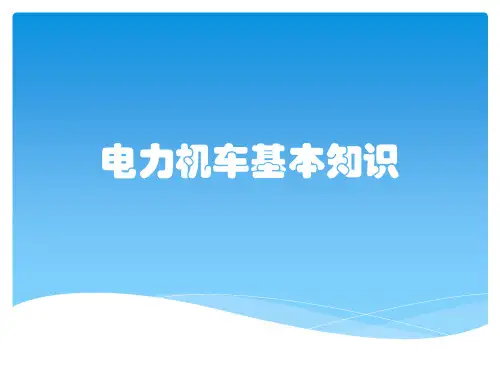
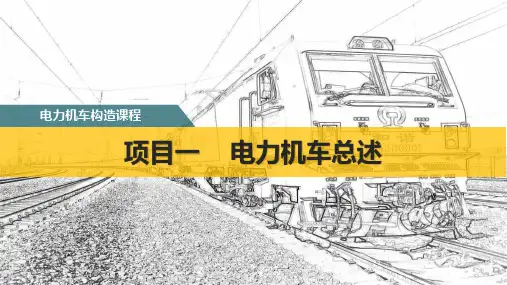
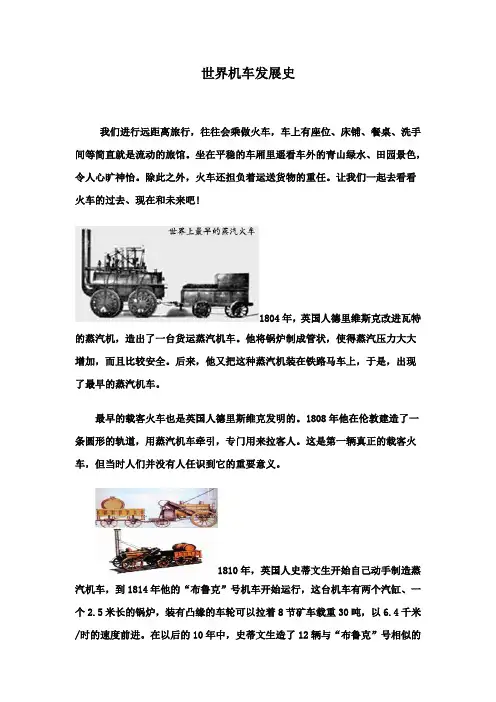
世界机车发展史我们进行远距离旅行,往往会乘做火车,车上有座位、床铺、餐桌、洗手间等简直就是流动的旅馆。
坐在平稳的车厢里遥看车外的青山绿水、田园景色,令人心旷神怡。
除此之外,火车还担负着运送货物的重任。
让我们一起去看看火车的过去、现在和未来吧!1804年,英国人德里维斯克改进瓦特的蒸汽机,造出了一台货运蒸汽机车。
他将锅炉制成管状,使得蒸汽压力大大增加,而且比较安全。
后来,他又把这种蒸汽机装在铁路马车上,于是,出现了最早的蒸汽机车。
最早的载客火车也是英国人德里斯维克发明的。
1808年他在伦敦建造了一条圆形的轨道,用蒸汽机车牵引,专门用来拉客人。
这是第一辆真正的载客火车,但当时人们并没有人任识到它的重要意义。
1810年,英国人史蒂文生开始自己动手制造蒸汽机车,到1814年他的“布鲁克”号机车开始运行,这台机车有两个汽缸、一个2.5米长的锅炉,装有凸缘的车轮可以拉着8节矿车载重30吨,以6.4千米/时的速度前进。
在以后的10年中,史蒂文生造了12辆与“布鲁克”号相似的火车头,虽然在设计上没有突破前人的成就,但他以经预见到火车时代即将到来。
18世纪初,随着生产力的发展和生产效率的不断提高,工厂迫切需要运进大量原材料,同时将产品输送到世界各地,人们渴望用蒸汽动力车取代马车,以加速交通运输的发展。
蒸汽机车运载能力大,而且能长距离运输,很快就夺得了运输业的冠军,使人们对它刮目相看。
1829年4月,利物浦—曼彻斯特铁路委员会宣布即将举行一次竞赛,要求每辆机车牵引一列满载石子的车辆,在长3000米的路上来回运行20次,优胜的机车设计者将得到500英镑奖金在10月份的比赛中,史蒂文生的“火箭”号机车牵引着重12吨的货车,以22.5千米/时的速度行驶,到第10次行驶时,他将速度提高到33.7千米/时,最后一次以47千米/时的速度高速前进,取得了比赛的冠军,到达终点时,数万观众脱帽欢呼,祝贺他的胜利。
从此,再也没有人对史蒂文生的才能和蒸汽机车发明人的身份表示怀疑了。
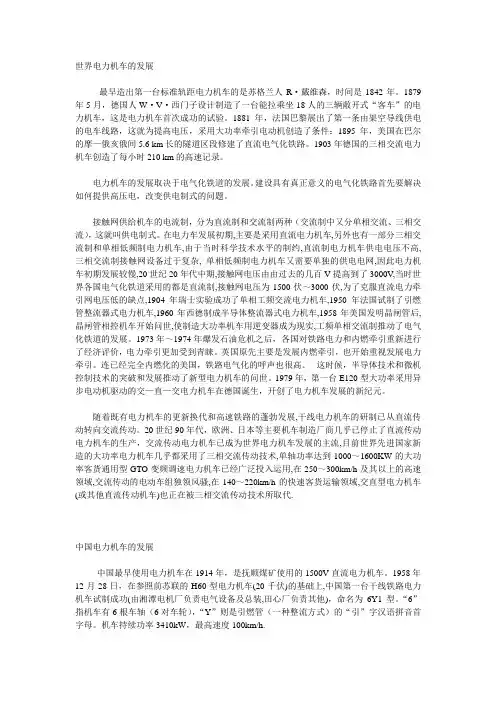
世界电力机车的发展最早造出第一台标准轨距电力机车的是苏格兰人R·戴维森,时间是1842年。
1879年5月,德国人W·V·西门子设计制造了一台能拉乘坐18人的三辆敞开式“客车”的电力机车,这是电力机车首次成功的试验。
1881年,法国巴黎展出了第一条由架空导线供电的电车线路,这就为提高电压,采用大功率牵引电动机创造了条件:1895年,美国在巴尔的摩—俄亥俄间5.6 km长的隧道区段修建了直流电气化铁路。
1903年德国的三相交流电力机车创造了每小时210 km的高速记录。
气化铁道的发展。
建设具有真正意义的电气化铁路首先要解决如何提供高压电,改变供电制式的问题。
流),这就叫供电制式。
在电力车发展初期,主要是采用直流电力机车,另外也有一部分三相交流制和单相低频制电力机车,由于当时科学技术水平的制约,直流制电力机车供电电压不高,三相交流制接触网设备过于复杂, 单相低频制电力机车又需要单独的供电电网,因此电力机车初期发展较慢,20世纪20年代中期,接触网电压由由过去的几百V提高到了3000V,当时世界各国电气化铁道采用的都是直流制,接触网电压为1500伏~3000伏,为了克服直流电力牵引网电压低的缺点,1904年瑞士实验成功了单相工频交流电力机车,1950年法国试制了引燃管整流器式电力机车,1960年西德制成半导体整流器式电力机车,1958年美国发明晶闸管后, 晶闸管相控机车开始问世,使制造大功率机车用逆变器成为现实,工频单相交流制推动了电气化铁道的发展。
1973年~1974年爆发石油危机之后,各国对铁路电力和内燃牵引重新进行了经济评价,电力牵引更加受到青睐。
英国原先主要是发展内燃牵引,也开始重视发展电力牵引。
连已经完全内燃化的美国,铁路电气化的呼声也很高。
这时候,半导体技术和微机控制技术的突破和发展推动了新型电力机车的问世。
1979年,第一台E120型大功率采用异步电动机驱动的交—直—交电力机车在德国诞生,开创了电力机车发展的新纪元。
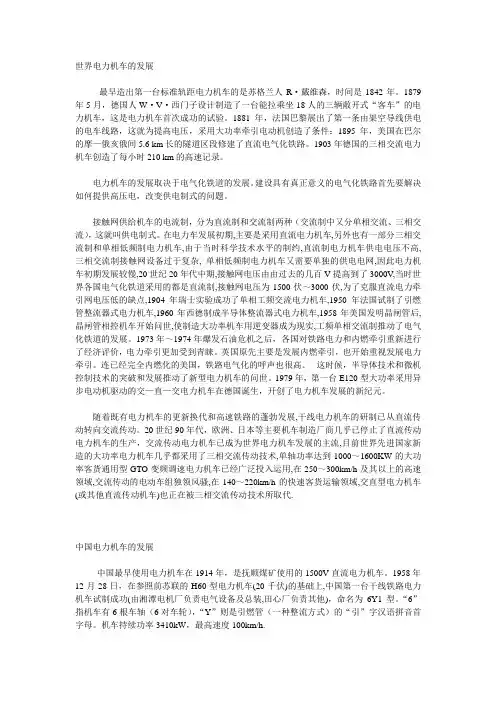
世界电力机车的发展最早造出第一台标准轨距电力机车的是苏格兰人R·戴维森,时间是1842年。
1879年5月,德国人W·V·西门子设计制造了一台能拉乘坐18人的三辆敞开式“客车”的电力机车,这是电力机车首次成功的试验。
1881年,法国巴黎展出了第一条由架空导线供电的电车线路,这就为提高电压,采用大功率牵引电动机创造了条件:1895年,美国在巴尔的摩—俄亥俄间5.6 km长的隧道区段修建了直流电气化铁路。
1903年德国的三相交流电力机车创造了每小时210 km的高速记录。
电力机车的发展取决于电气化铁道的发展。
建设具有真正意义的电气化铁路首先要解决如何提供高压电,改变供电制式的问题。
接触网供给机车的电流制,分为直流制和交流制两种(交流制中又分单相交流、三相交流),这就叫供电制式。
在电力车发展初期,主要是采用直流电力机车,另外也有一部分三相交流制和单相低频制电力机车,由于当时科学技术水平的制约,直流制电力机车供电电压不高,三相交流制接触网设备过于复杂, 单相低频制电力机车又需要单独的供电电网,因此电力机车初期发展较慢,20世纪20年代中期,接触网电压由由过去的几百V提高到了3000V,当时世界各国电气化铁道采用的都是直流制,接触网电压为1500伏~3000伏,为了克服直流电力牵引网电压低的缺点,1904年瑞士实验成功了单相工频交流电力机车,1950年法国试制了引燃管整流器式电力机车,1960年西德制成半导体整流器式电力机车,1958年美国发明晶闸管后, 晶闸管相控机车开始问世,使制造大功率机车用逆变器成为现实,工频单相交流制推动了电气化铁道的发展。
1973年~1974年爆发石油危机之后,各国对铁路电力和内燃牵引重新进行了经济评价,电力牵引更加受到青睐。
英国原先主要是发展内燃牵引,也开始重视发展电力牵引。
连已经完全内燃化的美国,铁路电气化的呼声也很高。
这时候,半导体技术和微机控制技术的突破和发展推动了新型电力机车的问世。
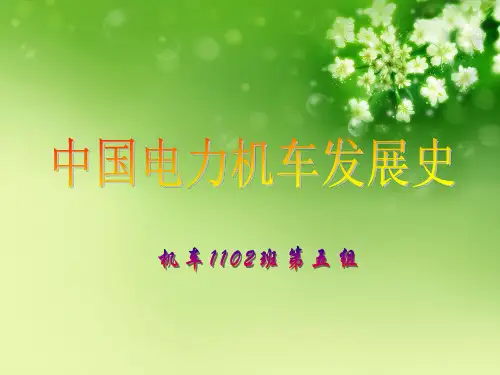
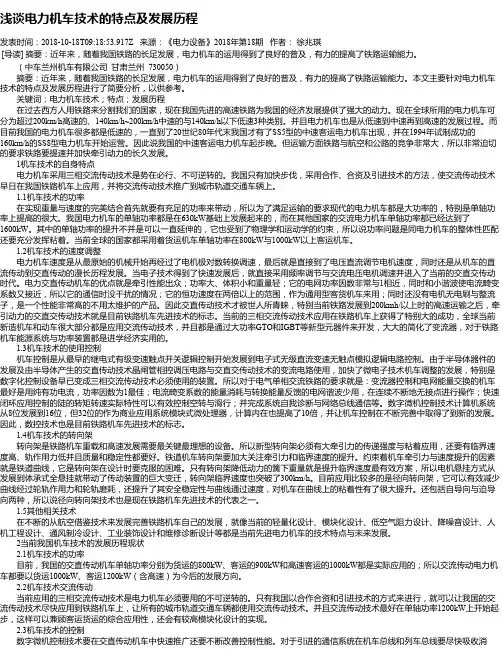
浅谈电力机车技术的特点及发展历程发表时间:2018-10-18T09:18:53.917Z 来源:《电力设备》2018年第18期作者:徐兆琪[导读] 摘要:近年来,随着我国铁路的长足发展,电力机车的运用得到了良好的普及,有力的提高了铁路运输能力。
(中车兰州机车有限公司甘肃兰州 730050)摘要:近年来,随着我国铁路的长足发展,电力机车的运用得到了良好的普及,有力的提高了铁路运输能力。
本文主要针对电力机车技术的特点及发展历程进行了简要分析,以供参考。
关键词:电力机车技术;特点;发展历程在过去西方人用铁路来分割我们的国家,现在我国先进的高速铁路为我国的经济发展提供了强大的动力。
现在全球所用的电力机车可分为超过200km/h高速的、140km/h~200km/h中速的与140km/h以下低速3种类别。
并且电力机车也是从低速到中速再到高速的发展过程。
而目前我国的电力机车很多都是低速的,一直到了20世纪80年代末我国才有了SS5型的中速客运电力机车出现,并在1994年试制成功的160km/h的SS8型电力机车开始运营。
因此说我国的中速客运电力机车起步晚。
但运输方面铁路与航空和公路的竞争非常大,所以非常迫切的要求铁路要提速并加快牵引动力的长久发展。
1机车技术的自身特点电力机车采用三相交流传动技术是势在必行、不可逆转的。
我国只有加快步伐,采用合作、合资及引进技术的方法,使交流传动技术早日在我国铁路机车上应用,并将交流传动技术推广到城市轨道交通车辆上。
1.1机车技术的功率在实现重量与速度的完美结合首先就要有充足的功率来带动,所以为了满足运输的要求现代的电力机车都是大功率的,特别是单轴功率上提高的很大。
我国电力机车的单轴功率都是在630kW基础上发展起来的,而在其他国家的交流电力机车单轴功率都已经达到了1600kW。
其中的单轴功率的提升不并是可以一直延伸的,它也受到了物理学和运动学的约束,所以说功率问题是同电力机车的整体性匹配还要充分发挥粘着。
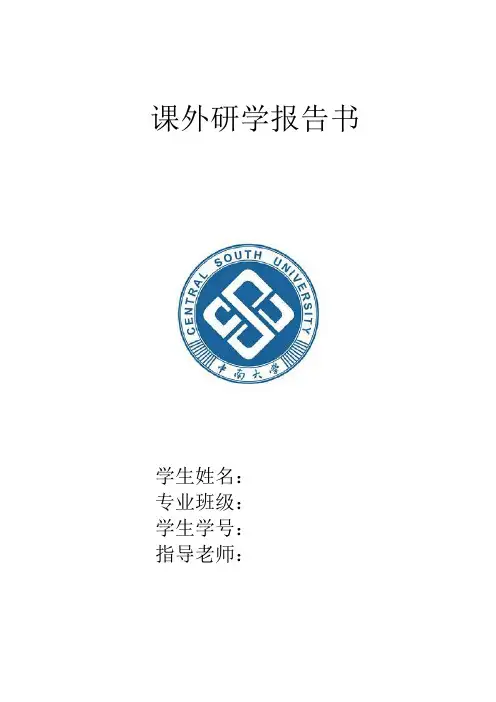
课外研学报告书学生姓名:专业班级:学生学号:指导老师:关于电力机车的探究一、机车的发展历史早在1804年,一个名叫德里维斯克的英国矿山技师,首先利用瓦特的蒸汽机造出了世界上第一台蒸汽机车。
这是一台单一汽缸蒸汽机,能牵引5节车厢,它的时速为5至6公里。
这台机车没有设计驾驶室,机车行驶时,驾驶员跟在车旁边走边驾驶。
因为当时使用煤炭或木柴做燃料,所以人们都叫它“火车”引,于是一直沿用至今。
人类历史上最重要的机械交通工具,早期称为蒸汽机车,也叫列车,有独立的轨道行驶。
铁路列车按载荷物,可分为运货的货车和载客的客车,亦有两者一起的客货车。
在1781年,火车先驱乔治.斯蒂芬森出生在一个英国矿工家庭。
直到18岁,他还是一个目不识丁的文盲。
他不顾别人的嘲笑,和七八岁的孩子一起坐在课堂里学习。
1810年,他开始制造蒸汽机车。
1817年,当斯蒂芬森决定他主持修建从利物浦到曼彻斯特的铁路线上完全用蒸汽机车承担运输任务。
但是,保守的铁路拥有者却对蒸汽机车的能力表示怀疑。
他们提出,在铁路边上固定的牵引机,用拖缆来牵引火车。
斯蒂芬森为了让人们充分相信火车的性能,制造出了性能良好的“火箭号”机车。
这种机车的卓越表现终于让怀疑者改变了态度,利物浦--曼彻斯特铁路因此成为世界上第一条完全靠蒸汽机运输的铁路线。
最早使用燃煤蒸汽动力的燃煤蒸汽机车有一个很大的缺点,就是必须在铁路沿线设置加煤、水的设施,还要在运营中耗用大量时间为机车添加煤和水,这些都很不经济。
在19世纪末,许多科学家转向研究电力和燃煤蒸汽机车。
世界上第一列真正在轨上行驶的蒸汽火车是由康瓦耳的工程师查理‧特里维西克所设计的。
它的火车有四个动力轮,1840年2月22日试车,空车时,时速20公里,载重时,每小时8公里(相当于人快步行走的速度)。
不幸,火车的重量压垮了铁轨。
1879年,德国西门子电气公司研制了第一台电力机车,重约954公斤,只在一次柏林贸易展览会上做了一次表演。
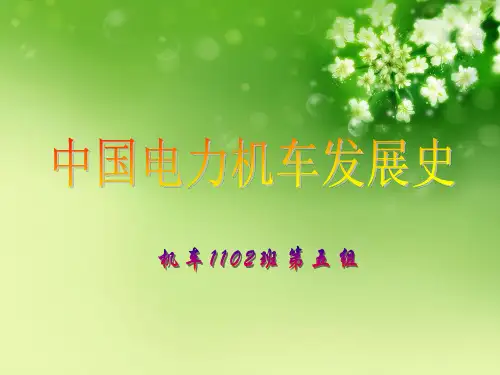
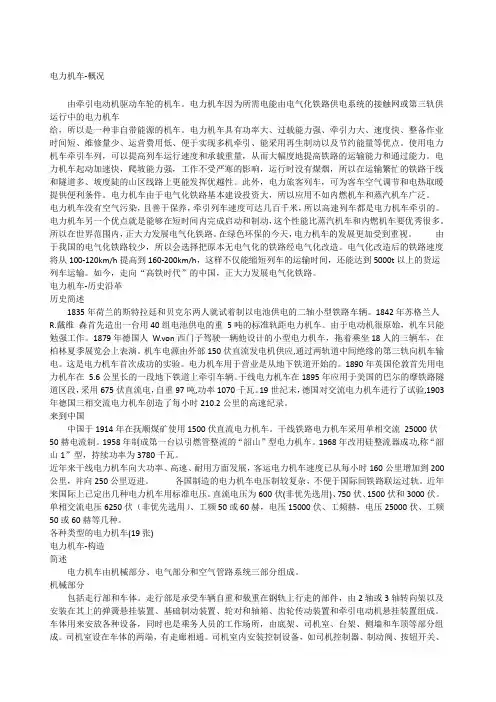
电力机车-概况由牵引电动机驱动车轮的机车。
电力机车因为所需电能由电气化铁路供电系统的接触网或第三轨供运行中的电力机车给,所以是一种非自带能源的机车。
电力机车具有功率大、过载能力强、牵引力大、速度快、整备作业时间短、维修量少、运营费用低、便于实现多机牵引、能采用再生制动以及节约能量等优点。
使用电力机车牵引车列,可以提高列车运行速度和承载重量,从而大幅度地提高铁路的运输能力和通过能力。
电力机车起动加速快,爬坡能力强,工作不受严寒的影响,运行时没有煤烟,所以在运输繁忙的铁路干线和隧道多、坡度陡的山区线路上更能发挥优越性。
此外,电力旅客列车,可为客车空气调节和电热取暖提供便利条件。
电力机车由于电气化铁路基本建设投资大,所以应用不如内燃机车和蒸汽机车广泛。
电力机车没有空气污染,且善于保养,牵引列车速度可达几百千米,所以高速列车都是电力机车牵引的。
电力机车另一个优点就是能够在短时间内完成启动和制动,这个性能比蒸汽机车和内燃机车要优秀很多。
所以在世界范围内,正大力发展电气化铁路。
在绿色环保的今天,电力机车的发展更加受到重视。
由于我国的电气化铁路较少,所以会选择把原本无电气化的铁路经电气化改造。
电气化改造后的铁路速度将从100-120km/h提高到160-200km/h,这样不仅能缩短列车的运输时间,还能达到5000t以上的货运列车运输。
如今,走向“高铁时代”的中国,正大力发展电气化铁路。
电力机车-历史沿革历史简述1835年荷兰的斯特拉廷和贝克尔两人就试着制以电池供电的二轴小型铁路车辆。
1842年苏格兰人R.戴维森首先造出一台用40组电池供电的重5吨的标准轨距电力机车。
由于电动机很原始,机车只能勉强工作。
1879年德国人W.von西门子驾驶一辆他设计的小型电力机车,拖着乘坐18人的三辆车,在柏林夏季展览会上表演。
机车电源由外部150伏直流发电机供应,通过两轨道中间绝缘的第三轨向机车输电。
这是电力机车首次成功的实验。
机车车辆的发展1 蒸汽机车1.1 蒸汽机车的起源1763年,法国陆军的技术军官古诺希望将蒸汽动力用于拉动兵工厂生产一种炮身由生铁铸成的沉重的大炮,1769年,古诺制成了他设想中的蒸汽动力车。
不过它的速度才有每小时四千米,并且由于锅炉里的蒸汽用完了,蒸汽动力车走了大约15分钟就停了下来,但是这个伟大的尝试揭开了人类探索蒸汽机车的序幕。
1804年英国的特里维西克制造出了第一台在轨道上行驶的蒸汽机车。
1814年斯蒂芬森制作的第一台名为“布鲁克”号的机车开始运行,这台机车有两个汽缸、一只2.5米长的锅炉,有凸缘车轮防止打滑,它可以拉着8节矿车,载重30吨,以每小时6.4千米的速度前进,这是被认为第一台成功的机车。
第一次运行时,煤矿上居民看到蒸汽机车的烟囱直往外喷火,就给它取了一个名字叫“火车”。
1829年斯蒂芬森父子设计建造的,并在英国的蒸汽机车比赛中获奖的“火箭”号蒸汽机车,已经具有了现代蒸汽机车的基本构造特征。
1.2 了解蒸汽机车蒸汽机车是利用蒸汽机把煤的热能变成机械能而运行的一种机车。
蒸汽机车产生动力的主要方式是通过机械或人力把煤放入机车锅炉火箱内的炉床上燃烧,产生的热能经过火箱板、拱砖管壁和锅胴部的大小烟管使锅炉内的水蒸发成为水蒸汽,然后将蒸汽由导汽管经调整阀导入汽缸,利用它的热能和膨胀力,推动活塞(鞲鞴)移动,蒸汽由汽缸活塞的前后两侧交替进入,并将废汽按一定规律排出,使活塞往复运动,再经过活塞杆、十字头、摇杆和曲柺销等传动装置推动动轮作回转运动,从而使机车运行。
蒸汽机车上需要携带一定数量的煤和水,因此运行一段距离后要加水加煤。
1.3 蒸汽机车的构造蒸汽机车构造与内燃机车、电力机车不同,其构造比较特殊。
蒸汽机车主要包括锅炉部、机械部、走行部和煤水车四大部分,其他还有车钩缓冲装置、制动装置、控制和监测装置、司机室和辅助装置等部分。
锅炉部的作用是使锅水吸收在炉床上燃烧的燃料释放出的热能而变为具有一定压强的蒸汽,并将蒸汽存储在锅炉中以备使用;机械部利用蒸汽在汽缸内膨胀做功,将热能变为机械能,通过与各动轮相连的连杆机构带动机车动轮转动;走形部承担机车上部重量,将机械部所作的功变为牵引力使列车运行,走行部一般都有导轮转向架帮助机车顺利通过曲线,而大功率蒸汽机车还有从轮转向架来承受锅炉火箱的重量;煤水车是装载煤、水、油脂和存放工具及备品的处所,连挂在机车的后部。
世界电力机车的发展最早造出第一台标准轨距电力机车的是苏格兰人R·戴维森,时间是1842年。
1879年5月,德国人W·V·西门子设计制造了一台能拉乘坐18人的三辆敞开式“客车”的电力机车,这是电力机车首次成功的试验。
1881年,法国巴黎展出了第一条由架空导线供电的电车线路,这就为提高电压,采用大功率牵引电动机创造了条件:1895年,美国在巴尔的摩—俄亥俄间5.6 km长的隧道区段修建了直流电气化铁路。
1903年德国的三相交流电力机车创造了每小时210 km的高速记录。
电力机车的发展取决于电气化铁道的发展。
建设具有真正意义的电气化铁路首先要解决如何提供高压电,改变供电制式的问题。
接触网供给机车的电流制,分为直流制和交流制两种(交流制中又分单相交流、三相交流),这就叫供电制式。
在电力车发展初期,主要是采用直流电力机车,另外也有一部分三相交流制和单相低频制电力机车,由于当时科学技术水平的制约,直流制电力机车供电电压不高,三相交流制接触网设备过于复杂, 单相低频制电力机车又需要单独的供电电网,因此电力机车初期发展较慢,20世纪20年代中期,接触网电压由由过去的几百V提高到了3000V,当时世界各国电气化铁道采用的都是直流制,接触网电压为1500伏~3000伏,为了克服直流电力牵引网电压低的缺点,1904年瑞士实验成功了单相工频交流电力机车,1950年法国试制了引燃管整流器式电力机车,1960年西德制成半导体整流器式电力机车,1958年美国发明晶闸管后, 晶闸管相控机车开始问世,使制造大功率机车用逆变器成为现实,工频单相交流制推动了电气化铁道的发展。
1973年~1974年爆发石油危机之后,各国对铁路电力和内燃牵引重新进行了经济评价,电力牵引更加受到青睐。
英国原先主要是发展内燃牵引,也开始重视发展电力牵引。
连已经完全内燃化的美国,铁路电气化的呼声也很高。
这时候,半导体技术和微机控制技术的突破和发展推动了新型电力机车的问世。
世界电力机车的发展中英文电力机车本身的原始动机同意触网发出的电流作为能源,由机车牵引电机驱动车轮。
随着电力机车功率,热效率,速度的提升,以及有力和可靠的操作过载能力成为其要紧优势,但不污染环境,因此专门适用于繁忙的铁路运输和隧道,以及斜坡的山区铁路。
电力机车从接触线获得电力,接触网供电电流机车差不多上直流和交流。
按照目前的供电电流形式的不同,而不涉及电力机车本身,电力机车系统可分为差不多直-直流电力机车,交-直流电力机车,交-直-交电力机车三种。
直-直流电力机车采纳直流电源系统,牵引变电所装有整流装置,它将成为一个三相交流-直流装置,然后访咨询互联网。
因此,电力机车可直截了当从网上联络供应DC系列直流牵引电动机使用,简化了机车设备。
直流系统的缺点是接触网电压低,通常l500伏或3000伏,接触线要求较粗,因此要消耗大量的有色金属,并增加建设投资。
关于交-直流电力机车交流电源系统,世界上大多数国家使用的是频率(50赫兹)交换系统,或25赫兹的低频通信系统。
在此电力供应系统中,牵引变电所将改为三相交流电频率的25千伏单相交流电源,然后传送到网络。
然而,在电力机车内使用的字符串仍旧是直流电动机(这是最大的优势:调速简单,只需改变电机端电压,因此就能够专门容易地实现在较大范畴内的机车速度,但这种电机由于需要使用换向器,制造和爱护是专门复杂的,体积更大),如此,交流到直流机车的转变任务完成。
接触网系统的直流电压没有提升专门多。
但接触导线的直径能够相对减少,从而减少了消费的非铁金属,但建设投资并没有减少。
因此,高频通信系统已被广泛采纳,世界上大多数的电力机车也开始采纳交-直流方式。
交-直-交流,交流非电力机车牵引电机换向器(即三相异步电动机),其在汽车制造,性能,功能,大小,重量,成本以及爱护性和可靠性等方面比换向器容易得多。
这是失败的电力机车,其要紧的缘故是提升速度相当困难。
但这种机车具有优良的牵引能力。
走进火车——电力机车篇蒸汽机的发明开启第一次工业革命,火车这一产物随之出现。
在十九世纪,随着资本主义经济的发展,自然科学研究取得重大进展,1870年以后,由此产生的各种新技术、新发明层出不穷,并被应用于各种工业生产领域,促进经济的进一步发展,第二次工业革命蓬勃兴起,人类进入了电气时代。
1866年,德国人西门子制成了发电机,电动机的性能得到了进一步的提升,人类正式迈入电力机车的时代。
1867年,西门子的电机公司制造出世界上第一辆电力机车,在巴黎博览会上展出,震惊了许多人。
1879年5月31日,在柏林的工商业博览会上,这辆世界上第一辆电力机车公开试运行。
这台机车重量不到1吨,只有954千克,车上装有3马力直流电动机,由带电铁轨输送电流,一次可运旅客18人,时速7公里。
由于机车车身小,没有驾驶台,操纵杠和刹车都装在靠前轮的地方,所以司机只好骑在车头上驾驶。
该机车用电动机车牵引,由带电铁轨输送电流,功率为3马力,一次可运旅客18人,时速7公里。
这台“不冒烟的”机车,引起了人们的极大兴趣。
两年之后1881年,柏林郊外铺设了电气化轨道,规模虽小、但已成为世界最初营业用的电车路线。
现在,这辆电力机车陈列在慕尼黑德意志科技博物馆内。
带电铁轨运用在一些线路中并不适合,这要考虑到诸如与地面绝缘,维护人员作业等很多方面的问题,一旦发生漏电等现象后果往往是致命的。
后来德国又试验成功架空接触导线供电系统,使电力机车的供电线路由地面转向空中,机车的'电压和功率都大大提高。
这种供电方式一直沿用至今,成为大家所熟知的电气化铁路接触网供电系统。
电力机车本身没有动力来源,运行所需的电能需要依靠外部的电缆或电轨等。
若遇自然灾害、战争等不可抗力状况引发断电就无法运行,导致运输瘫痪,甚至可能引起事故。
例如2008年我国华南地区遭遇大面积强降雪,损坏了铁路沿途线上的供电设备,致使多个班次的电力火车停运,造成严重的旅客滞留。
其次在建造电气化铁路所投入的成本比非电气化铁路大得多,维护工作增加了不少。
1. 绪论1.1 国内外大功率机车发展状况本论文主要内容是分析设计大功率电力机车的空气管路系统的设计,设计思想将主要参考目前的SS7D型大功率电力机车的空气管路系统,并对其与HXD2型机车进行对比,在此基础上进行改进和创新。
改进和创新的重点在关键设备的选用,控制方式变化。
SS7D 型电力机车是为满足我国铁路客运提速需要,由大同机车厂、株洲电力机车研究所、成都车辆厂共同开发的持续功率4800kW、最高时速170kM的准高速客运电力机车。
SS7D型机车的空气管路系统吸收了当时国内外先进电力技术,并根据准高速机车要求研制的。
制动系统使用DK-1制动机,利用DKL作为制动控制系统,相比以前的纯空气制动控制系统控制性能更加优越,可靠性更高。
HXD2型大功率交流传动机车是由法国阿尔斯通交通运输股份有限公司和中国北车集团大同电力机车有限责任公司为中国大秦线牵引2万吨重载货运列车而联合设计的一种新型重载货运交流传动机车。
HXD2型机车制动系统采用Eurotrol型制动机,它是在原SAB WABCO微机控制电空制动机基础上,按照中国大秦线重载运输环境需求和中国铁道车辆制动机特点,并满足中国铁路运用要求开发出来的新一代机车制动系统。
HXD2型机车的每节机车各有一套完全相同的制动系统。
Eurotrol制动机在正常工况时,通过微机控制列车管压力实现列车的制动与缓解。
当A节机车制动系统出现严重故障时,机车制动系统能转换到B节机车制动系统从而正常控制列车的制动与缓解。
HXD2型机车空气管路与制动系统设计始终贯穿模块化﹑信息化﹑标准化的设计理念。
制动系统采用先进的微机网络控制﹑整体集成气路屏﹑空电联合制动﹑不锈钢管路等新技术,突破了传统模式,进一步提高了系统的先进性和可靠性。
HXD2(和谐电2)型电力机车为八轴大功率交流传动货运机车,由大同电力机车有限责任公司与法国阿尔斯通交通股份公司在阿尔斯通公司的PRIMABB4370电力机车的基础上联合开发。
中国铁路电力机车的发展趋势研究分析一.现代高速铁路发展对电力机车牵引动力的需求1. 高速铁路货运特点:重载高速,集中化,单元化。
大型化,标准化的集装箱运输。
节省包装简化手续。
案例:俄罗斯曾实验开行4340吨由440辆车组成的长6.5公里的由4台电力机车牵引的重载列车。
2.铁路客运特点:高速度,大密度,高频率。
多采用电力机车牵引动车组,双层车厢。
3.电气化铁路成为发展趋势:向交直交传动,计算机控制系统电力机车牵引方向发展。
4.我国高速铁路的发展趋势。
高速铁路:高速重载铁路。
列车速度为200公里/小时。
(UIC国际铁路联盟定义)安全,准时,快速,方便,舒适,环保。
科技含量高,制动性强,运量大,适用于城际之间高频运输。
对线路要求复线,站间距离长,线路尽可能平直,多立交和封闭性,牵引动力多采用电力机车,或电力机车动车组(客运)。
要求列车车体有强大的制动性能。
车体流线型,减少阻力。
安装列车自动控制装置。
对牵引动力的需求:需要采用电力机车或(磁悬浮),功率和牵引动力更大,有新型的动力装置和传动装置。
要求:动力采用相对集中或分散(日本动车组),法国(相对集中),德国(两种兼备)。
在高速条件下先进的制动技术提高和改进。
对电力机车要求可靠性高的受电技术和装备。
要求车载微机控制列车牵引,需要新型制动和智能控制技术。
列车牵引和车辆发展趋势,要求适用高速条件下车体的走型部和外型。
二.我国电气铁路和电力机车发展简史:1.1958年研制出我国第一台电力机车。
1961年中国第一条电气化铁路宝风线(宝鸡到风洲)93公里建成。
1980年中国电气化铁路里程达到1033公里。
电力机车保有量达到210台。
1988年电气里程5737公里,电力机车1224台。
完成总运量的13.4%。
1997年电气铁路达到11637.7公里,不含香港34公里和台湾498公里,电力机车保有量2870台,完成总运量的27%2.电力机车技术引进和早期研制:第一代电力机车。
试谈世界电力机车的发展(doc 8页)世界电力机车的发展电力机车本身的原始动机接受触网发出的电流作为能源,由机车牵引电机驱动车轮。
随着电力机车功率,热效率,速度的提高,以及有力和可靠的操作过载能力成为其主要优势,但不污染环境,所以特别适用于繁忙的铁路运输和隧道,以及斜坡的山区铁路。
电力机车从接触线获得电力,接触网供电电流机车都是直流和交流。
根据目前的供电电流形式的不同,而不涉及电力机车本身,电力机车系统可分为基本直-直流电力机车,交-直流电力机车,交-直-交电力机车三种。
直-直流电力机车采用直流电源系统,牵引变电所装有整流装置,它将成为一个三相交流-直流装置,然后访问互联网。
因此,电力机车可直接从网上联络供应DC系列直流牵引电动机使用,简化了机车设备。
直流系统的缺点是接触网电压低,通常l500伏或3000伏,接触线要求较粗,因此要消耗大量的有色金属,并增加建设投资。
对于交-直流电力机车交流电源系统,世界上大多数国家使用的是频率(50赫兹)交换系统,或25赫兹的低频通信系统。
在此电力供应系统中,牵引变电所将改为三相交流电频率的25千伏单相交流电源,然后传送到网络。
但是,在电力机车上使用的字符串仍然是直流电动机(这是最大的优势:调速简单,只需改变电机端电压,因此就可以很容易地实现在较大范围内的机车速度,但这种电机由于需要使用换向器,制造和维护是非常复杂的,体积更大),这样,交流到直流机车的转变任务完成。
接触网系统的直流电压没有提高很多。
但接触导线的直径可以相对减少,从而减少了消费的非铁金属,但建设投资并没有减少。
因此,高频通信系统已被广泛采用,世界上大多数的电力机车也开始采用交-直流方式。
交-直-交流,交流非电力机车牵引电机换向器(即三相异步电动机),其在汽车制造,性能,功能,大小,重量,成本以及维护性和可靠性等方面比换向器容易得多。
这是失败的电力机车,其主要的原因是提高速度相当困难。
但这种机车具有优良的牵引能力。
因此还是大有希望。
德国制造的电力机车E120就是这不断,到1976年,L型作出韶山(韶山Ⅰ型)第131号,已基本确立。
直到1989年停止生产的最后期限,SSL电力机车共有926家台湾制造商,成为我国第一个电气化铁路主要火车头。
1966列SS2机车于1978年研制成功。
不仅使SS3型机车牵引性能改进,而且每小时的机车功率从200kW至4千瓦,截止到1997年底,共生产了987列,成为第一次中国两种主要的电力机车。
1985年还成功地发展了SS4型8轴货运电力机车,这是我国最大功率的电力机车(6400千瓦),已成为我国主要的重型货运机车。
然后又成功继承发展SS5 ,SS6和SS7型电力机车。
1994年已成功地发展了速度达160公里的高速电力机车以及其他4轴电力机车。
伴随着世界潮流,诞生了新的“直-交”电力机车技术。
从20世纪70年代末,我国一直在进行中小型铁路功率变换器的研究。
在地面上的高功率测试也在进行中,直-交流电力机车研究也已取得初步成效。
发展我国电力机车始于1958年。
在那个时候,铁道部第三机车厂,即现在的株洲电力机车厂在协助湘潭电机采矿电力机车制造工厂的同时,设计和编制铁路电力机车。
1958年年初,该部机械工业部组织第一次访问苏联考察。
在那个时候,基本定型的观念是:由于苏联使用20千伏单相交流系统Н60频率电力机车,因此中方决定采取25千伏单相交流系统,并且频率各不相同。
所以Н60电力机车是一个大胆的技术改造,这相当于78个重大变化。
1958年12月28日,我国第一台电力机车研制成功的铁路干线,命名“Y1-6”,机车持续功率3410千瓦,最高速度100公里/小时。
到目前为止,我国干线电力机车已基本形成了4,6,8轴和3200千瓦,6400千瓦和4800千瓦幂级数。
1999年5月26日,我国的株洲电力机车厂生产了第一个速度超过200公里DDJ1子弹头型电力机车,标志着我国电力牵引已跻身于国际高速列车服务行列。
The Development of World Electric Locomotive Electric locomotive itself with the original motive accept catenary sent by the current as a source of energy, from locomotive traction motor drive the wheels. With electric locomotive power, thermal efficiency, fast, strong and reliable operation Guozainaili major advantages, but do not pollute the environment, and particularly applicable to the busy railway transportation and tunnels, the slope of the mountain railway.Electric locomotive from the contact line access to electricity, catenary power supply current locomotives are both DC and AC. The current system different, notwith the electric locomotive, can be divided into basically straight-DC electric locomotive, the TAC-DC electric locomotive, the TAC-Direct-AC electric locomotive three.Straight-DC electric locomotive using DC power supply system, traction substation equipped with rectifier devices, it will become a three-phase AC DC, and then to access the Internet. Therefore, the electric locomotive can be made online directly from the contact supply DC Series traction motor use, which simplifies the locomotive equipment. DC system's weaknesses are catenary low voltage, typically l500V or 3000 V, the contact wire request is rough, it is necessary to consume a large amount of non-ferrous metals, and increased construction investment.TAC - DC electric locomotive powered by AC system, most of the world's countries use the frequency (50Hz) exchange system, or 25 Hz low-frequency communication system. In this supply system, traction substation will be changed to three-phase alternating current frequency of 25 kV single-phase AC power industry after exposure to the Internet. But in the electric locomotive used on the string is still DC motor (which is the biggest advantage motor speed as simple as changing motor terminal voltage, it should be easy to achieve in the larger context of the locomotive speed, but such Motor due to the commutator, manufacturing and maintenance are very complex, and also greater volume), the AC into DC locomotive in the task completed. The catenary system DC voltage than to raise a lot of contact wire diameter can be relatively reduced, reducing the consumption of non-ferrous metals and construction investment did not. Therefore, the frequency communication system has been widely adopted by majority of the world's electric locomotive also pay - DC electric locomotive.TAC-Direct-exchange by exchange of non-electric locomotive traction motor commutator (that is, three-phase asynchronous motors),which is in the motor manufacturing, performance, functionality, size, weight, cost, maintenance and reliability and so on than the motor commutator much easier. It is the failure of the electric locomotive, is the main reason for speed rather difficult. This locomotive has excellent traction capacity promising. German-made electric locomotive E120 This is the locomotive.The working principle of electric locomotive, the current contact wire, and withstand electric locomotive into the arch after re-entering the circuit breaker after the main transformer, AC traction from the main transformer winding throughsilicon rectifier units, divided into two groups of six parallel to the traction motor DC supply concentrate to a traction motor torque, the mechanical energy into electric energy through the transmission gear-driven locomotive drive wheels turning.The development of electric locomotives:The first to create the first standard gauge electric locomotive is the Scots R Davidson, time is 1842. May 1879, the German Siemens W V design and manufacture of a 18 - to pull on the three open "passenger" electric locomotive, this is the first electric locomotive successful pilot. 1881, Paris, France at the first of electricity from overhead wires tram lines, which for the upgrade, using high-power traction motors to create the conditions: 1895, the United States in Baltimore - Ohio between 5.6 km long tunnel section DC electrified railway construction. 1903 Germany's three-phase AC electric locomotive created a 210 km per hour high-speed recording.Electric locomotive of development depends on the development of electrified railway. Build a real sense electrified railway is first necessary to resolve how to provide high-voltage, change standard power supply problems.Catenary locomotive current supply system, divided into DC system and the exchange of two (AC system in the single-phase AC again, three-phase AC), which called power supply standard. The frequency of the single-phase AC system to promote the development of electrified railway. 20 in the early 1970s, continental Europe and Japan in Asia is basically realized transport busy main railway electrification. 1973 ~ 1974 outbreak of the oil crisis, the national electricity and internal combustion of the railway traction re-evaluation of the economic, favored by the more electric traction. Britain is the development of the original diesel traction, but also started to attach importance to the development of electric traction. Even completely internal combustion of the United States, the voice of railway electrification also high. To the early 1980s, the world had more than 50 countries and regions to build the electrified railway, the Soviet Union's total length of electrified railway reached over 40,000 kilometers, Japan, France, West Germany have a more than 10,000 km of electrified Railway. At present, the world electrified railway has reached more than 20 million kilometres, China has also joined the more than 10,000 km of electrified railways, "senior club".Electrified railway power supply problems are solved, the development ofhigh-power, high-speed electric locomotive on a national pursuit of the goal. At this time, the semiconductor technology and computer control technology breakthroughs and promoting the development of the birth of a new electric locomotive. 1979, the first high-power AC drive E120-electric locomotive was born in Germany, opened a new era in the development of electric locomotives.With the upgrading of existing electric locomotive and the vigorous development of high-speed railway, the development of Route electric locomotive drive from DC to AC. In the 1990s, Europe, Japan and other major motorcycle manufacturers have nearly halted DC drive electric locomotive production, AC electric locomotive has become the world's electric locomotive the mainstream of development.China's electric locomotive:Shaoshan an electric locomotive of China's earliest use of electric locomotive in 1914, is the use of the Fushun Coal Mine 1500 V DC electric locomotive. 1958 China has successfully produced the first electric locomotive, from the ignition of a rectifier to silicon rectifier, locomotives constantly improve and enhance performance, to 1976 l-made Shaoshan (SS1 type) No. 131, has been basically established. The deadline for the cessation of production in 1989, SSl electric locomotive has a total of 926 Taiwan manufacturers to become China's first electrified railway main locomotive. 1966 SS2 locomotive made in 1978 successfully developed SS3 locomotive not only improved traction performance, also of the hours of locomotive power from 200kW to a 4 kW 4800, deadline to the end of 1997, produced a total of 987, becoming the first Chinese two kinds of main electric locomotive. 1985 also has succeeded in the development of SS4 8 axis freight electric locomotive, it is China's largest electric locomotive power in a (6400 kW), has become China's main heavy-duty freight locomotive. After the successful development of a succession SS5, SS6 and SS7 electric locomotive. 1994 has succeeded in the development speed of 160 km of high-speed electric locomotive, and other 4-axis.World track for the new “pay-direct-diplomacy”electric locomotive new technology, from the late 1970s, China has been carrying out small and medium-sized railway power converter units on the ground and high-power test on the Hand-Direct-AC electric locomotive Research has also achieved initial success.Development of China's electric locomotive began in 1958. At that time, the Ministry of Railways San locomotive factory, which is now the Zhuzhou ElectricLocomotive Factory in assisting the Xiangtan Electrical mining electric locomotive manufacturing plant at the same time, design and Preparation railway electric locomotive. Early 1958, the Ministry of Machinery Industry organized by the Department of the first mission to the Soviet Union study tour. At that time, the basic stereotypes of the Soviet Union is the use of 20 kV single-phase AC system Н60 frequency electric locomotive, and China decided to adopt the 25 kV single-phase AC system frequency vary, so Н60 electric locomotive on a bold technological transformation, which amounted to 78 major changes.December 28,1958, China's first electric locomotive Taiwan Railway Route Preparation successful named Y1-6.Locomotive 3410 kW continuous power, a maximum speed of 100 km / H .So far, China Route electric locomotive has been basically formed a 4,6,8 axis and 3200 kW, 6400 kW and 4800 kW power series. May 26, 1999, China's Zhuzhou Electric Locomotive Works produced the first speed of over 200 km DDJ1“bullet” electric locomotive, indicates that China has ranked as one of the electric traction in the international high-speed train service.。